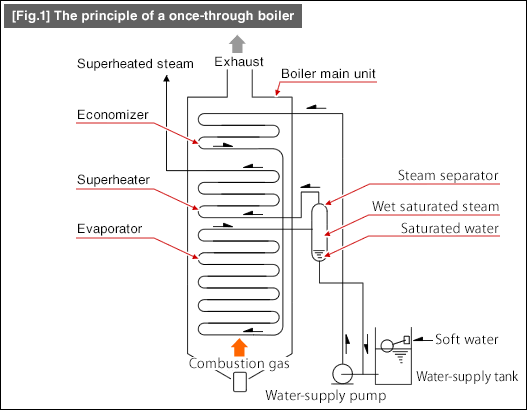#211 Heat-Saving Measures - Boilers
While many types of boilers are available, the ones adopted for projects involving surface treatments are usually once-through or water-tube boilers in smaller sizes.
A boiler is a device used to create steam by heating up water using fuel and to transport the steam to a heating object. From its function of conveying the heat energy from fuel to a heating object through water, you could say that a boiler works as a heat exchanger.
[Fig.1] shows the principle of a one-through boiler. The exhaust heat recovery area called the 'economizer' preheats water pumped through boiler water tubes. The water starts boiling in the tubes while it circulates from the lowest-temperature to the highest-temperature area in the combustion chamber. At this time, water and steam coexist. The water and steam mixture is sent to the steam separator where water droplets are removed from the steam by gravity. The water droplets are then transported back to the water-supply pump.
Heating up the steam separated from the water at a temperature higher than its vaporization point generates "superheated steam" to be supplied to a heating object through the main steam valve.
As shown in [Table 1], the boiler water quantity is relatively low for the once-through boiler. This means that it produces high-quality steam (extremely dry and high-energy steam) in a remarkably short length of time.

[Table 1] Example of boiler water quantity and concentration factor for a once-through boiler
|
The important factors in applying heat-saving measures for a boiler include proper management of fuel, boiler feed-water, boiler water (water in the boiler chamber), steam, exhaust gas, and drain as well as the appropriate combustion control. The concentration factor shown in [Table 1] means that impurities in the boiler water become concentrated by this factor when operating the boiler for one hour. Failure to eliminate impurities (Ca, Mg, silicate, hydrochloric acid, oxygen gas, etc.) completely from the boiler water or feed water may cause the water tube to clog or corrode. To prevent these problems, it is necessary to implement the proper management of feed water and boiler water. The feed water management includes demineralization using ion-exchange resin and degassing. As for the boiler water management, boiler water is blown off (discharged) on a periodic basis.
When choosing fuel, important characteristics to look out for are high calorific value per unit weight, ease of combustion control, no air contaminants, and high thermal efficiency of the boiler, in addition to the purchase price.
- Environmental conservation
- Hot Dipping
- Anodic Oxidation Process
- Anodic oxidation treatment
- Anodizing
- Corrosion - Corrosion Protection
- Electroless Plating
- Electroplating
- Heat treating
- Hydrogen embrittlement
- Metal cleaning
- Metal etching
- Painting
- Special paints
- Surface Treatment
- Surface-treated steel sheets
- Thermal Spraying



